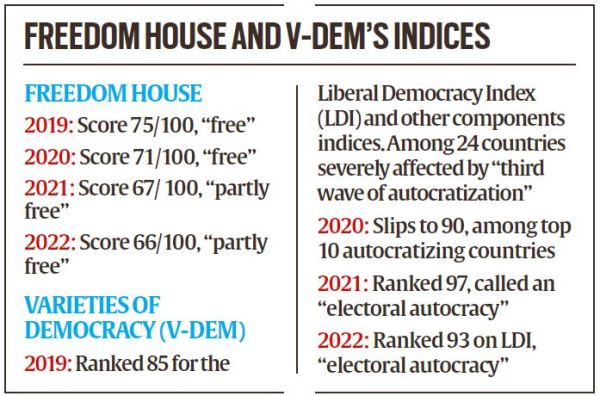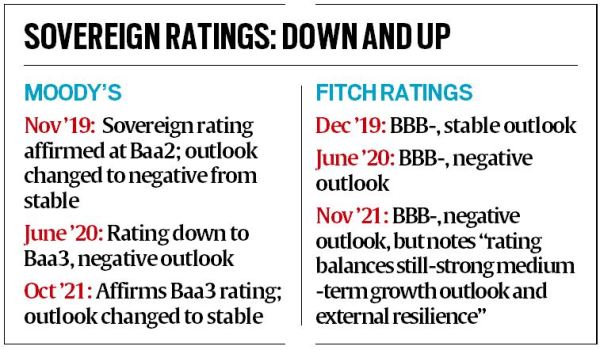Worried India rating may turn junk, govt pushed ‘narrative management’ strategy

AS the country fought the first wave of the Covid-19 pandemic in mid-2020, the Ministry of Finance’s economic division was drafting a strategy to counter the “negative commentary” on India by global think-tanks, indices, and media, amidst worries that this could lead to downgrading of sovereign rating to “junk”.
In June 2020, then Principal Economic Advisor in the Ministry of Finance, Sanjeev Sanyal, prepared a presentation — “Subjective Factors that impact India’s Sovereign Ratings: What can we do about it?” — for internal circulation within the government. Sanyal is now a member of the Prime Minister’s Economic Advisory Council.

The 36-page presentation, seen by The Indian Express, noted that 18-26 per cent of a country’s sovereign rating is based on subjective factors such as assessments on governance, political stability, rule of law, corruption, press freedom, and so on.
 “In most cases, India’s ranking on these subjective factors is well below peers. This pulls down its sovereign ratings,” it said. Rating agencies, according to Sanyal, used the World Bank’s World Governance Indicators (WGI) as a proxy for these subjective factors. Highlighting WGI as the single-most important index, it said, the inputs that go into the making of the WGI were “arbitrary” and based on impressions from the Western press or small surveys of NGOs and a handful of academics.
“In most cases, India’s ranking on these subjective factors is well below peers. This pulls down its sovereign ratings,” it said. Rating agencies, according to Sanyal, used the World Bank’s World Governance Indicators (WGI) as a proxy for these subjective factors. Highlighting WGI as the single-most important index, it said, the inputs that go into the making of the WGI were “arbitrary” and based on impressions from the Western press or small surveys of NGOs and a handful of academics.
“There is a danger that we may witness a drop in WGI scores due to the latest negative commentary on India by think tanks, survey agencies and international media. This could possibly downgrade our Sovereign Ratings to junk. Hence, it is of utmost importance to reach out to these think-tanks and survey agencies and set a positive narrative about India in general,” Sanyal said in the presentation.
When contacted by The Indian Express, Sanyal declined to comment, and said: “We never comment on internal presentations.”
Observing that most reports in 2019-20 projected a “negative commentary” on India, the presentation noted: “Specifically, Jammu and Kashmir Reorganisation Act of 2019, Citizenship Amendment Act, 2019, National Register of Citizens and construction of a Hindu temple at a disputed religious site by Prime Minister Narendra Modi and his ‘Hindu nationalist’ Bharatiya Janata Party are seen as an exercise ‘targeting Muslims’ and ‘threatening secular nature’ of our country.”

In fact, Moody’s had downgraded India on June 1, 2020, from Baa2 to Baa3 (the lowest investment grade of ratings) and maintained a negative outlook. Amongst other reasons, Moody’s had said: “Governance is material to India’s credit profile and a material factor in today’s downgrade… Policymakers’ limited success in achieving stated objectives in recent years – an important aspect of governance under Moody’s definitions — together with Moody’s expectation that policymaking will remain challenged is an important driver in both the downgrade to Baa3 and the assignment of a negative outlook.”
Fitch Ratings too revised India’s outlook to negative from stable on June 18, 2020, although it affirmed the rating at BBB-. In its explanation, among other aspects, Fitch said, “Relations with Pakistan are, moreover, negatively affected by the repeal of the special status for Kashmir and recent changes to the status of illegal immigrants based on their religion. A stronger focus by the ruling Bharatiya Janata Party on its Hindu-nationalist agenda since the government’s re-election in May 2019 risks becoming a distraction for economic reform implementation and could further raise social tensions.”
Sanyal said the “consistent” negative commentary about India was also becoming the opinion of sovereign rating agencies, and the finance ministry’s protests on such opinion reaped no results. “Experience is that the rating agencies will usually go ahead and publish,” his presentation said.
The government did reach out to sovereign rating agencies in the coming months. On October 5, 2021, Moody’s Investors Service raised the outlook on India’s sovereign rating to ‘stable’ from ‘negative’ in a revision after almost two years, minimising the chances of any rating downgrade.
Both Moody’s and Fitch Ratings declined to comment on queries sent by The Indian Express.
Sanyal’s presentation said the WGI was based on 32 third party sources and has been updated annually since 2002. Of these 32 data sources, 24 incorporate India, but not all sources score countries on all six WGI parameters. “The WGI scores run with a two-year lag. Hence, the latest available scores are for the year 2018. However, most third-party sources publish their reports every year. The commentary in these reports provides a clear indication of which way the scores will move in the coming years,” it said.
“We need to reach out to the top third-party sources – initiate continuous discussions, clearly spell out the country’s reform measures and sensitise them of our internal matters,” it said.
The government felt that there was a need to keep continuous engagements with third party sources of WGI to set “positive narrative about India in general” adding that “last moment protests are of no use.” Most of these sources seem to be swayed by general western media and NGO narratives rather than any in-depth objective analysis, it said, emphasising “consistent narrative management is important”.
“In many cases, the think-tanks do not have an India expert or have not updated their information. Many of them base their rankings on cursory surveys of opinions from a small number of journalists/ NGOs/ academics. The government needs to think of ways to reach out to these agencies, initiate continuous discussions, clearly spell out the country’s reform measures and sensitise them on our internal matters and better understand their methodologies as well,” the presentation said.
Newsletter | Click to get the day’s best explainers in your inbox
In the analysis of Sanyal’s team, the top 15 data sources, whose ratings have the maximum impact on India’s overall WGI scores: Economist Intelligence Unit, World Justice Project, Political Risk Services International Country Risk Guide, WEF Global Competitiveness Report, Institutional Profiles Database, Global Insight Business Conditions & Risk Indicators, Bertelsmann Transformation Index, IFAD Rural Sector Performance Assessments, Institute for Management & Development World Competitiveness Yearbook, Varieties of Democracy Project, Freedom House, JET Country Security Risk Ratings, Cingranelli-Richards Human Rights Database & Political Terror Scale, Heritage Foundation Index of Economic Freedom, and Political Economic Risk Consultancy Corruption in Asia Survey.
About three – Economist Intelligence Unit, Varieties of Democracy (V-Dem) Project and Freedom House – have a negative stance about India. “While the rest 12 have a relatively neutral stance, their India scores are either stagnant or rising/falling gradually. These are low hanging fruits. We must target them first in changing India’s perception. This will not only help in preserving our current sovereign ratings but also in getting future upgrades,” it said.

